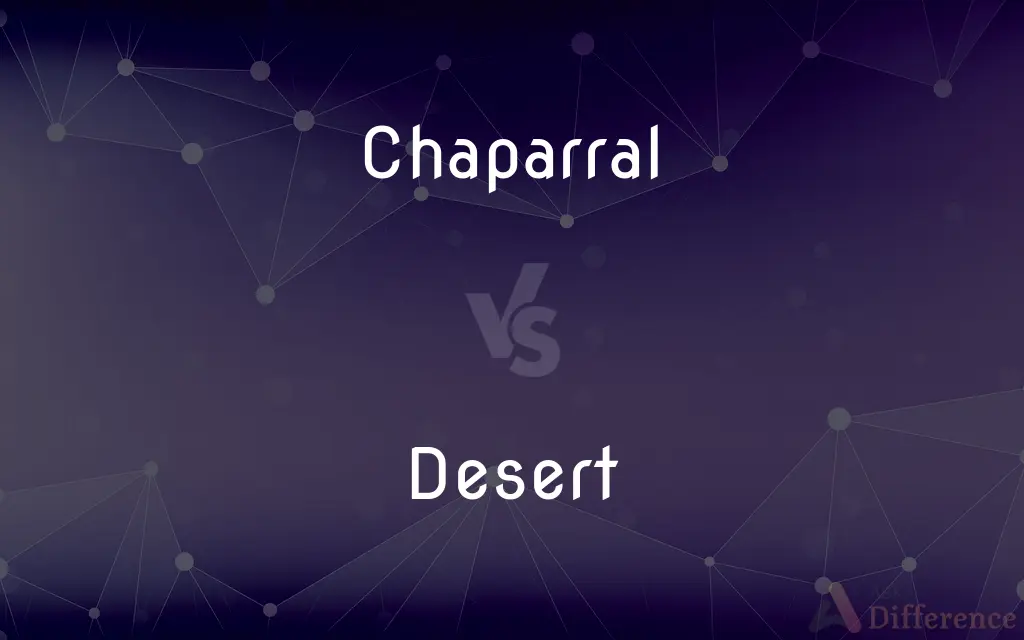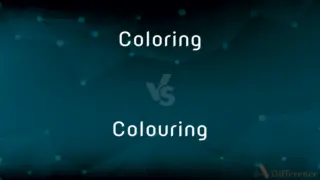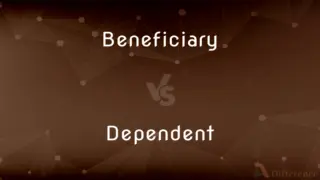Chaparral vs. Desert — What's the Difference?
By Urooj Arif & Fiza Rafique — Updated on May 2, 2024
Chaparral biomes are characterized by dense, shrubby vegetation and a Mediterranean climate, whereas deserts are defined by their extreme aridity and sparse vegetation.

Difference Between Chaparral and Desert
Table of Contents
ADVERTISEMENT
Key Differences
Chaparral is a biome typified by evergreen shrubs and a climate with mild, wet winters and hot, dry summers. Whereas, deserts are often characterized by sandy or rocky landscapes and receive less than 25 cm of rainfall annually.
The chaparral biome thrives in coastal regions that benefit from oceanic influences, promoting moderate temperatures. On the other hand, deserts can be found in a variety of climates and are typically subject to more extreme temperature fluctuations between day and night.
Vegetation in the chaparral has adapted to survive frequent fires with thick, fire-resistant leaves and seeds that germinate post-fire. In contrast, desert plants like cacti have adapted to conserve water, featuring thick, fleshy structures that store moisture.
Animal life in the chaparral includes species adapted to a diet of dense, tough vegetation and a limited water supply, such as deer and various rodents. Conversely, desert animals often exhibit nocturnal behavior to avoid daytime heat and conserve water.
Human impact on chaparrals often involves development pressures and fire management challenges, whereas desert areas face issues related to water resource management and habitat preservation due to their sparse water availability.
ADVERTISEMENT
Comparison Chart
Climate
Mild, wet winters; hot, dry summers
Extremely arid, little rainfall
Vegetation
Dense, evergreen shrubs
Sparse; cacti, small bushes, grasses
Location
Coastal regions, primarily Mediterranean
Various, including tropical and polar
Animal Adaptations
Adapted to dense vegetation, less water
Nocturnal habits, water conservation
Human Impact
Development pressure, fire management
Water scarcity, habitat preservation
Compare with Definitions
Chaparral
Adapted to environments with wet winters and very dry summers.
Plants in the chaparral have deep root systems to survive dry spells.
Desert
Hosts organisms highly adapted to the extreme arid climate.
Desert plants like cacti store water in their thick stems to survive.
Chaparral
A biome characterized by dense shrubbery and a Mediterranean climate.
The chaparral region is prone to wildfires during the dry summer months.
Desert
A barren area of landscape where little precipitation occurs and conditions are hostile for plant and animal life.
The Sahara Desert is one of the largest and hottest deserts in the world.
Chaparral
Dominated by woody plants, shrubs, and an evergreen landscape.
In the chaparral, oak and manzanita dominate the hilly terrains.
Desert
Subject to significant diurnal temperature variations.
Temperatures in the desert can plummet at night as compared to the daytime heat.
Chaparral
Frequent location for human development and urban sprawl.
Urban expansion into chaparral areas increases the risk of fire.
Desert
Often characterized by sand dunes, rocky plateaus, and very few water sources.
Navigation in deserts often involves traveling from one oasis to another.
Chaparral
Contains a biodiversity adapted to fire and drought conditions.
After a fire, chaparral ecosystems typically regenerate rapidly.
Desert
Faces environmental challenges such as water scarcity and overexploitation.
Water management is crucial for life in desert communities.
Chaparral
Chaparral ( shap-ə-RAL, chap-) is a shrubland plant community found primarily in the U.S. state of California, in southern Oregon, and in the northern portion of the Baja California Peninsula in Mexico. It is shaped by a Mediterranean climate (mild wet winters and hot dry summers) and infrequent, high-intensity crown fires.
Desert
A desert is a barren area of landscape where little precipitation occurs and, consequently, living conditions are hostile for plant and animal life. The lack of vegetation exposes the unprotected surface of the ground to the processes of denudation.
Chaparral
An area covered by a dense growth of mostly small-leaved evergreen shrubs, especially in central and southern California.
Desert
Abandon (a person, cause, or organization) in a way considered disloyal or treacherous
We feel our public representatives have deserted us
Chaparral
(US) A region of shrubs, typically dry in the summer and rainy in the winter. The coast of the Mediterranean is such a region.
Desert
A waterless, desolate area of land with little or no vegetation, typically one covered with sand
The desert of the Sinai peninsula is a harsh place
Drought and deforestation are turning fragile grasslands into desert
Chaparral
The foliage of creosote bush, Larrea divaricata, when used as a medicinal herb.
Desert
A flock of lapwings
A desert of lapwings rises from a ploughed field
Chaparral
A thicket of low evergreen oaks.
Desert
Like a desert
Overgrazing has created desert conditions
Chaparral
An almost impenetrable thicket or succession of thickets of thorny shrubs and brambles.
Desert
A dry, often sandy region of little rainfall, extreme temperatures, and sparse vegetation.
Chaparral
Dense vegetation consisting of stunted trees or bushes
Desert
A region of permanent cold that is largely or entirely devoid of life.
Desert
An apparently lifeless area of water.
Desert
An empty or forsaken place; a wasteland
A cultural desert.
Desert
(Archaic) A wild and uninhabited region.
Desert
Often deserts Something that is deserved or merited, especially a punishment
They got their just deserts when the scheme was finally uncovered.
Desert
The state or fact of deserving reward or punishment.
Desert
Of, relating to, characteristic of, or inhabiting a desert
Desert fauna.
Desert
Wild and uninhabited
A desert island.
Desert
To leave empty or alone; abandon.
Desert
To withdraw from, especially in spite of a responsibility or duty; forsake
Deserted her friend in a time of need.
Desert
To abandon (a military post, for example) in violation of orders or an oath.
Desert
To forsake one's duty or post, especially to be absent without leave from the armed forces with no intention of returning.
Desert
That which is deserved or merited; a just punishment or reward.
Desert
A barren area of land or desolate terrain, especially one with little water or vegetation; a wasteland.
Desert
(figuratively) Any barren place or situation.
Desert
Usually of a place: abandoned, deserted, or uninhabited.
They were marooned on a desert island in the Pacific.
Desert
To leave (anything that depends on one's presence to survive, exist, or succeed), especially when contrary to a promise or obligation; to abandon; to forsake.
You can't just drive off and desert me here, in the middle of nowhere.
Desert
To leave one's duty or post, especially to leave a military or naval unit without permission.
Anyone found deserting will be punished.
Desert
That which is deserved; the reward or the punishment justly due; claim to recompense, usually in a good sense; right to reward; merit.
According to their deserts will I judge them.
Andronicus, surnamed PiusFor many good and great deserts to Rome.
His reputation falls far below his desert.
Desert
A deserted or forsaken region; a barren tract incapable of supporting population, as the vast sand plains of Asia and Africa which are destitute of moisture and vegetation.
A dreary desert and a gloomy waste.
Desert
A tract, which may be capable of sustaining a population, but has been left unoccupied and uncultivated; a wilderness; a solitary place.
He will make her wilderness like Eden, and her desert like the garden of the Lord.
Before her extendedDreary and vast and silent, the desert of life.
Desert
Of or pertaining to a desert; forsaken; without life or cultivation; unproductive; waste; barren; wild; desolate; solitary; as, they landed on a desert island.
He . . . went aside privately into a desert place.
Full many a flower is born to blush unseen,And waste its sweetness on the desert air.
Desert
To leave (especially something which one should stay by and support); to leave in the lurch; to abandon; to forsake; - implying blame, except sometimes when used of localities; as, to desert a friend, a principle, a cause, one's country.
Desert
To abandon (the service) without leave; to forsake in violation of duty; to abscond from; as, to desert the army; to desert one's colors.
Desert
To abandon a service without leave; to quit military service without permission, before the expiration of one's term; to abscond.
The soldiers . . . deserted in numbers.
Desert
An arid region with little or no vegetation
Desert
Leave someone who needs or counts on you; leave in the lurch;
The mother deserted her children
Desert
Desert (a cause, a country or an army), often in order to join the opposing cause, country, or army;
If soldiers deserted Hitler's army, they were shot
Desert
Located in a dismal or remote area; desolate;
A desert island
A godforsaken wilderness crossroads
A wild stretch of land
Waste places
Common Curiosities
What animals are common in chaparral biomes?
Common animals include coyotes, deer, various birds, and rodents that have adapted to the dense vegetation and climatic conditions.
What defines a chaparral biome?
A chaparral biome is defined by its dense vegetation, typically evergreen shrubs and trees, and a Mediterranean climate with mild, wet winters and hot, dry summers.
How do plants in the desert conserve water?
Desert plants often have adaptations like waxy coatings on leaves, deep root systems, and the ability to store water in their tissues to minimize water loss.
Are deserts always hot?
No, deserts can also be cold, such as the Gobi Desert in Asia, where temperatures can drop below freezing.
Can deserts be found in cold regions?
Yes, cold deserts exist, such as the Gobi Desert in Mongolia, which experiences very low temperatures, especially in winter.
Are there any specific conservation concerns for deserts?
Yes, concerns include the preservation of scarce water resources, protection of native species adapted to harsh conditions, and the impact of human activities such as mining and off-road vehicle use.
What is the primary climate difference between chaparral and desert?
The primary difference is that chaparral has a Mediterranean climate with mild, wet winters and hot, dry summers, while deserts are characterized by extreme aridity throughout the year with very little rainfall.
What adaptations help animals survive in chaparral biomes?
Animals in chaparral biomes often have adaptations for dealing with heat and dry conditions, such as being nocturnal to avoid daytime heat and having water-conserving features.
How does the biodiversity of chaparral compare to that of deserts?
Chaparral generally supports higher biodiversity due to its more moderate climate and diverse plant life, which provides more resources and habitats for animals compared to the more extreme and less hospitable desert environment.
What types of vegetation are typical in a desert?
Typical desert vegetation includes cacti, succulents, small bushes, and hardy grasses, all adapted to conserve water and withstand harsh sunlight.
What causes the frequent fires in chaparral biomes?
Frequent fires in chaparral biomes are often due to the dry conditions, especially in summer and fall, combined with the abundance of flammable vegetation.
How do people manage resources differently in chaparral versus desert biomes?
In chaparral regions, managing wildfire risk and balancing urban expansion are primary concerns, while in deserts, the focus is more on water conservation and managing the impacts of resource extraction.
What role does temperature play in the life of desert plants and animals?
Temperature plays a critical role; many desert organisms are nocturnal to avoid the extreme heat of the day, and plants often have features to minimize water loss during the hottest parts.
Share Your Discovery

Previous Comparison
Coloring vs. Colouring
Next Comparison
Beneficiary vs. DependentAuthor Spotlight
Written by
Urooj ArifUrooj is a skilled content writer at Ask Difference, known for her exceptional ability to simplify complex topics into engaging and informative content. With a passion for research and a flair for clear, concise writing, she consistently delivers articles that resonate with our diverse audience.
Co-written by
Fiza RafiqueFiza Rafique is a skilled content writer at AskDifference.com, where she meticulously refines and enhances written pieces. Drawing from her vast editorial expertise, Fiza ensures clarity, accuracy, and precision in every article. Passionate about language, she continually seeks to elevate the quality of content for readers worldwide.













































